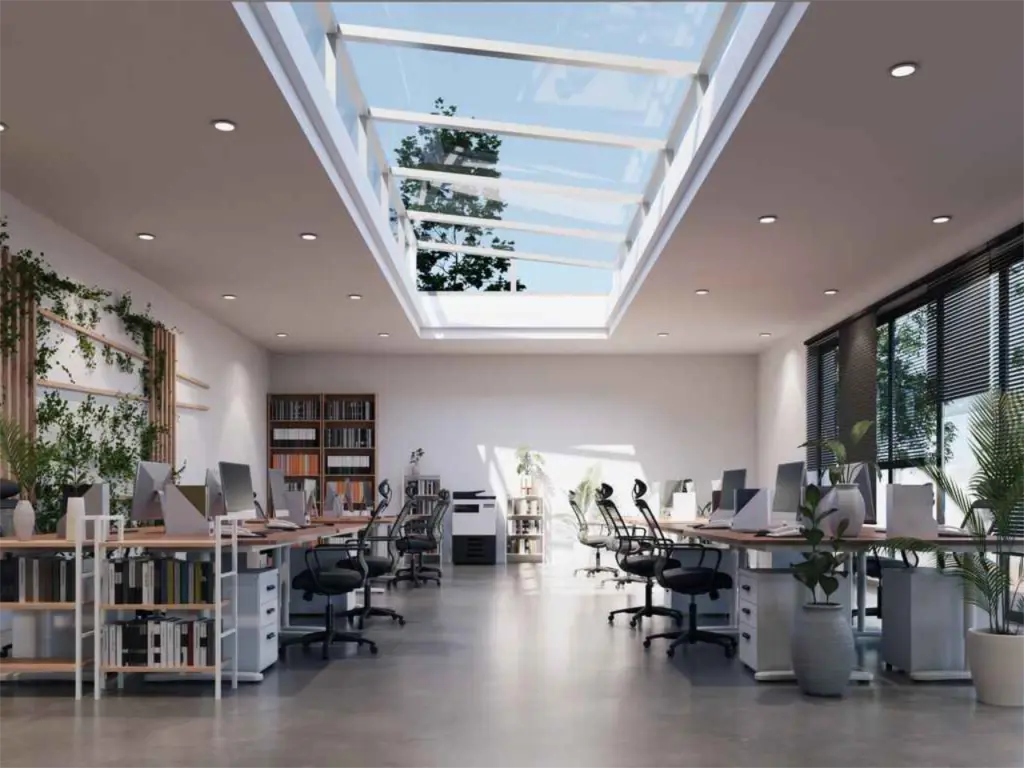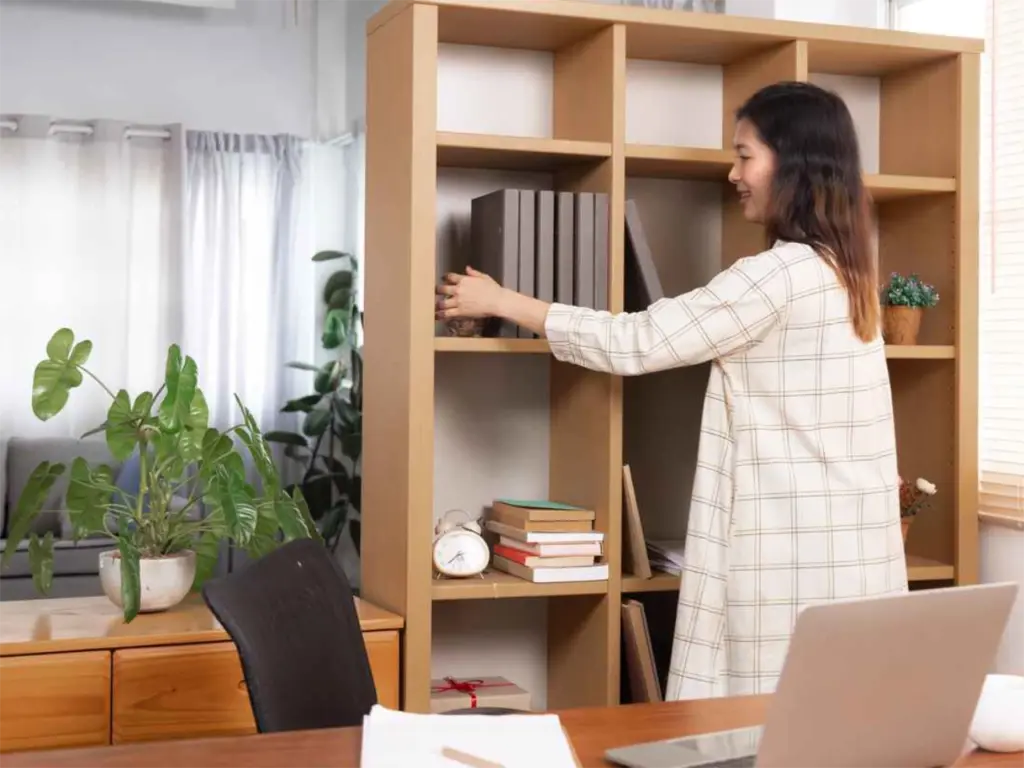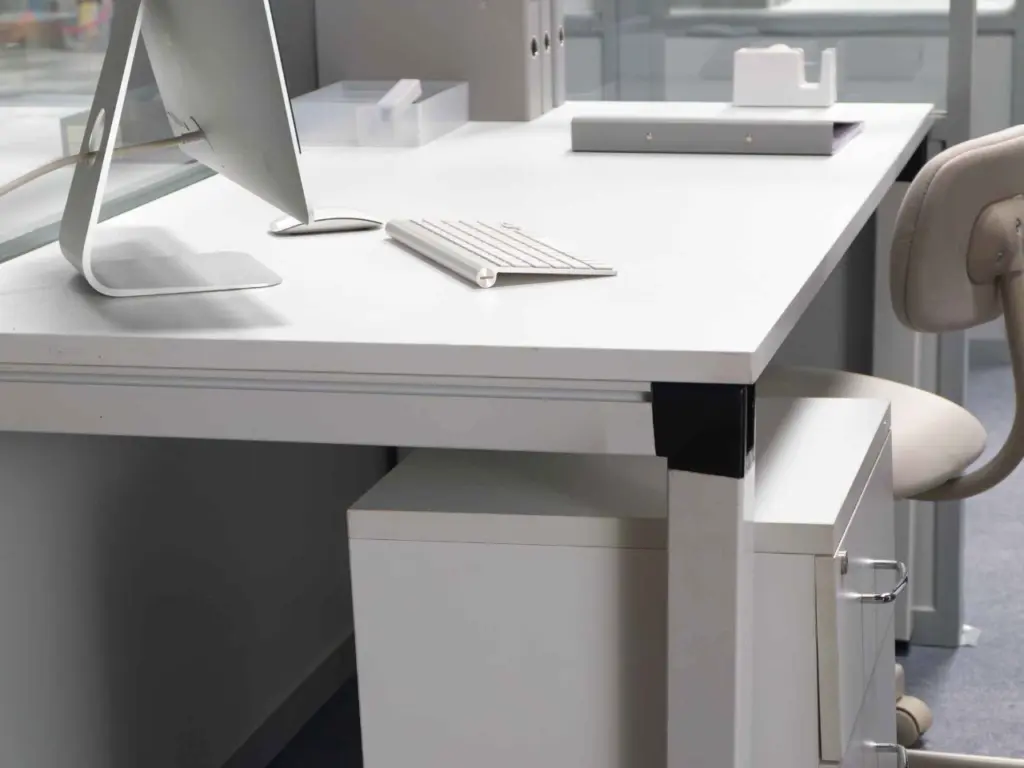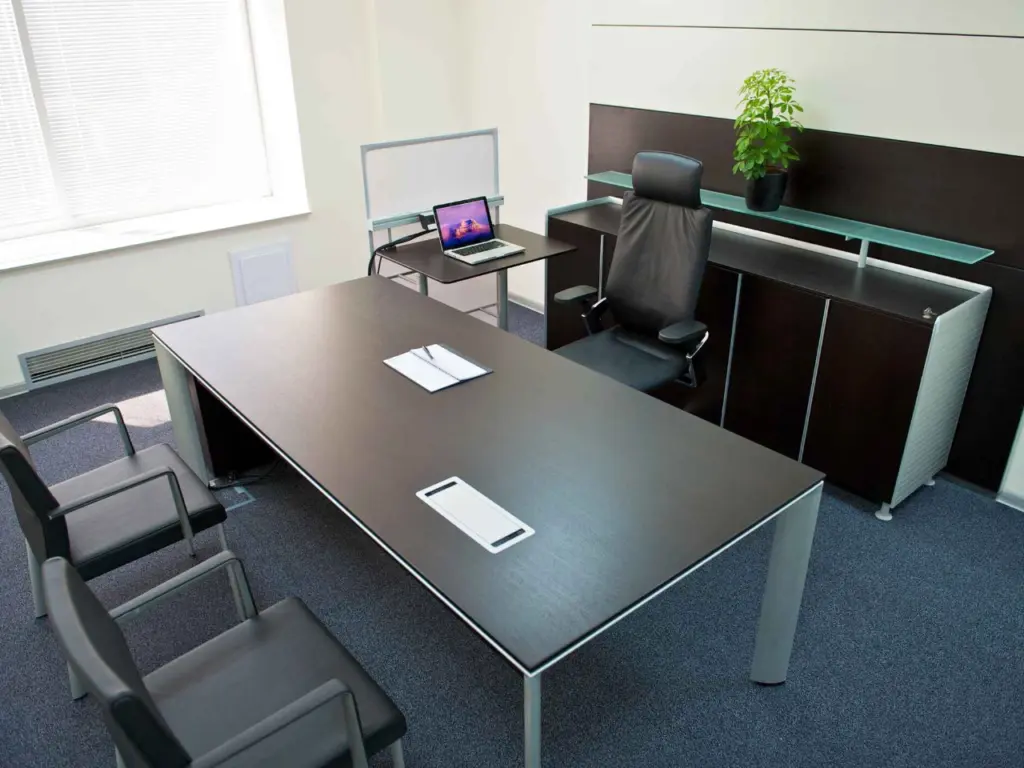Are you looking to transform your office into a space that maximizes productivity and ensures comfort? Creating an effective and inspiring office environment is crucial, whether updating your home office or designing a new workspace.
By incorporating exquisite and efficient design ideas—from ergonomic furniture to innovative storage solutions—you can significantly enhance both function and style.
This article explores creative solutions and practical tips that will help you optimize your workspace and make it uniquely suited to your needs. Ready to discover how the perfect design can elevate your workday? Read on to learn more!
What is Office Design, and Why Does It Matter?
Office design is the process of creating functional, comfortable, and aesthetically pleasing workspaces. Whether for a home office or a large corporate office space, the design instantly affects how people feel and perform in their work setting. From the selection of furnishings to the layout, the design plays a crucial role in boosting productivity, ensuring employee satisfaction, and reflecting the company’s culture.
- Office design impacts employee morale and well-being.
- Well-thought-out designs help facilitate better communication and collaboration.
- A well-designed office reflects a company’s values and branding.
- Effective office design improves productivity and efficiency.
- The layout and ergonomics of office furniture can reduce physical strain and prevent injury.
- Strategic placement of workstations and meeting areas can enhance workflow and operational efficiency.
- Design elements, such as colour schemes and decor, can create a pleasant work environment and inspire creativity.
- Incorporating natural elements and adequate lighting can improve focus and reduce stress.
- Customizable workspaces cater to various work styles and preferences, increasing overall satisfaction.
- Sustainable design choices contribute to environmental responsibility and can boost a company’s reputation.
What Makes an Office Design Effective?

A good office design is not just about aesthetics; it plays a significant role in enhancing productivity and employee satisfaction. Effective office design means combining functionality, comfort, and flexibility.
- Comfortable seating: Ergonomic design, especially in desk chairs, plays a critical role in long-term productivity.
- Collaborative spaces: Integrating flexible and collaborative areas helps promote teamwork and innovation.
- Personalized touches: Adding components like family photographs or unique decor helps employees feel more connected to their workspace.
- Acoustic design: Proper soundproofing and noise management ensure a quiet environment conducive to focused work while allowing for collaborative discussions.
- Smart technology integration: Seamlessly integrating technology, such as video conferencing tools, smart boards, and wireless charging, improves efficiency and communication.
- Biophilic elements: Incorporating plants and natural materials enhances air quality and creates a calming, pleasant atmosphere.
- Efficient space planning: Maximizing space utilization ensures that every spot contributes to productivity without overcrowding.
An effective office design should prioritize both form and function, making the office environment conducive to focus, creativity, and collaboration.
Maximizing Your Workspace: Tips and Tricks

Efficient use of space can impact the office interior design and is important for creating a productive office environment. Here are some tips to optimize your workspace:
Declutter Your Workspace
- Essential Items Only: Keep only necessary items on your desk to reduce clutter and maintain an organized workplace design.
- Organizational Tools: Use desk organizers, drawer dividers, and filing systems to manage office supplies and documents effectively.
Utilize Vertical Storage Solutions
- Wall-Mounted Shelves: Install wall-mounted shelves to keep your desk area clear and store books, office supplies, and decorative items.
- Cabinetry: Incorporate built-in or freestanding cabinets to house additional materials, keeping your desk area tidy and enhancing your office interior.
Incorporate Multifunctional Furniture
- Desks with Built-In Drawers: Go for desks with built-in drawers to reduce the need for separate filing cabinets and keep your workspace efficient.
- Wall-Mounted Desks: Consider wall-mounted desks that fold away when not in use, ideal for small or home office spaces.
Optimize Desk Arrangement
- Desk Placement: Position your desk to maximize natural light and minimize screen glare, enhancing your workspace functionality.
- Ergonomic Setup: Arrange your desk chair and monitor to support good posture and comfort, improving productivity and reducing strain.
Incorporate Decorative Elements
- Gallery Wall: Add a gallery wall with artwork or personal photos to personalize your workspace while keeping it functional.
- Personal Touches: Include decorative items like vases or family photographs to make your office environment inviting and reflective of your personality.
Use Modular and Flexible Solutions
- Modular Furniture: Choose modular furniture that can be reconfigured to suit different tasks and work styles.
- Adjustable Features: choose furniture with adjustable features, such as height-adjustable desks and swivel chairs, for enhanced comfort and flexibility.
Implement Space-Saving Ideas
- Under-Desk Storage: Utilize under-desk storage solutions like compact drawers or hanging organizers to maximize space efficiency.
- Floating Desks: Consider floating desks or wall-mounted work surfaces to create a more open and versatile office layout.
Enhance Lighting and Ambiance
- Task Lighting: Use task lighting, such as adjustable desk lamps, for focused lighting and reduced eye strain.
- Ambient Lighting: Incorporate ambient lighting to create a comfortable office atmosphere with adjustable options like dimmable lights or floor lamps.
By applying these strategies, you can effectively maximize your workspace, ensuring a functional and organized office environment that enhances productivity and comfort.
Exploring Workspace Options: Home Offices vs. Traditional Offices
If you’re looking for home office design ideas, you might wonder how they differ from traditional offices. Each type of workspace offers its own set of benefits and design considerations.
- Home Offices: These should blend into the home’s overall interior, offering a balance between professional functionality and home comfort.
- Traditional Offices: Corporate workspaces prioritize productivity, with collaborative spaces and ergonomic furnishings to facilitate work.
- Flexibility: Home office layouts often need to accommodate multiple purposes, such as converting a guest room into a workspace.
Whether you’re renovating a traditional office or setting up a home office, understanding the unique needs of each space is key to creating a functional and inspiring work environment.
How to Choose the Perfect Desk for Your Office Space

A desk is the centrepiece of any office, whether at home or in a corporate setting. Choosing the right desk can enhance both the practicality and aesthetic of your workspace.
- Size and Shape: Make sure the desk fits your space without overwhelming it. A compact desk may work best for a home office nook, while a larger desk suits more expansive office spaces.
- Storage Solutions: Look for desks with built-in cabinetry or drawers to help you stay organized.
- Materials: Desks made from natural materials like wood can add warmth to your interior design.
- Functionality: Get a desk that meets your specific needs, whether it’s for a home office idea involving creative projects or a more traditional workspace.
- Ease of Assembly and Maintenance: Choose a desk that is easy to assemble and maintain.
- Ergonomics and Comfort: Go for desks that accommodate comfortable seating and allow for proper ergonomics.
Picking the perfect desk helps to streamline workflow and keeps your office environment clutter-free.
Creating a Productive Nook in Your Home Office
A productive nook can be a game-changer, especially in smaller home offices. By strategically selecting the right corner or space, you can create a focused, serene environment.
- Small spaces, big impact: Even a small nook can provide an ideal work area if it includes the right desk, comfortable seating, and a well-placed lamp.
- Neutral decor: Opting for a neutral color palette keeps the space calm and avoids distractions.
- Lighting: A strategically placed lamp or pendant light can make all the difference in focus and productivity.
A well-thought-out nook transforms even the smallest area into a fully functional home office.
Designing with a Gallery Wall to Enhance Creativity
A gallery wall is a great addition to any office interior, as it adds personality while boosting creativity. This is particularly effective in home offices where you’re looking to inject a personal touch.
- Pieces of art: Choose prints or photos that inspire you and reflect your design journey.
- Family photographs: Including family memories can make the workspace feel more personal and cozy.
- Nook or entire room: Whether it’s a single wall in a nook or spread across an entire room, gallery walls offer limitless customization.
A well-curated gallery wall helps create a workspace that feels both personal and professional, fostering creativity.
Choosing the Right Seating for Comfort and Style

The right seating options can make or break your workday comfort. An ergonomic and stylish desk chair is a must for any workplace or home office.
- Look for chairs with adjustable features like lumbar support, seat height, tilt mechanisms, and swivel capabilities to promote comfort and proper posture during long working hours.
- Consider adding alternative seating like a banquette or comfortable lounge chairs in collaborative spaces for a more relaxed and inviting atmosphere.
- Sculptural seating can act as both a functional piece and an artistic focal point, blending comfort with design in your workspace.
- Prioritize materials like breathable fabric, leather, or mesh for long-lasting comfort and durability in your office chairs.
- Add flexible seating options like ottomans or stools, which can be moved easily for spontaneous meetings or as extra seating when needed.
- Choose chairs that match the style and overall aesthetic of your workspace, ensuring that style isn’t sacrificed for comfort.
- Test different seating options to ensure that they fit both your body and the nature of your work, whether it’s a sleek task chair or a more casual lounge seat.
- Comfortable seating in break areas can help employees unwind and boost morale, contributing to a more balanced and productive office environment.
- Ensure ergonomic certification. Look for seating options with ergonomic certifications to guarantee optimal support and alignment for long-term use.
Choosing the right seat is crucial for maintaining comfort and boosting productivity in any work environment.
Key Office Design Trends
Office design trends are all about balancing comfort with innovation, and functionality with creativity.
- Biophilic Design: Bringing elements of nature, like greenery and natural materials, into the workspace helps to reduce stress and enhance focus.
- Minimalist Aesthetics: Less is more, with clean lines and simple, functional furniture dominating the design landscape.
- Modular Layouts: Flexibility in seating and workspace configurations allows for both individual focus and collaborative work.
These trends are shaping the future of workplace design, making offices more adaptable and enjoyable spaces to be in.
How to Bring Biophilic Design into Your Workplace
Biophilic design, which highlights a connection to nature, is becoming increasingly popular. This approach incorporates natural light, greenery, and organic materials into the office space.
- Natural Light: Maximize windows and skylights to bring in as much sunlight as possible.
- Greenery: Adding plants or green walls can purify the air and reduce stress in the workplace.
- Natural Materials: Incorporating wood, stone, and other natural materials in your design and furnishings creates a more inviting, calming atmosphere.
Integrating biophilic elements can help create a serene and productive workspace.
Minimalist and Modular Design for Modern Offices
Minimalist office design prioritizes simplicity, with clean lines and a clutter-free environment. Modular designs add flexibility, making spaces easily adaptable to changing work needs.
- Clean and Functional: Minimalist offices focus on essential furnishings, cutting out unnecessary decor or clutter.
- Modular Furniture: Modular desks and seating options allow you to rearrange your office layout based on current projects or team needs.
- Neutral Palette: A neutral colour scheme, such as beige or off-white, enhances the minimalist aesthetic.
Whether you’re redesigning a corporate office or creating a home office layout, minimalist and modular design principles offer flexibility and simplicity.
The Power of Natural Light in Office Interior Design

Natural light is one of the most important design elements in any office. It not only enhances the visual appeal of the space but also improves mood and productivity.
- Positioning: When setting up your workspace, strategically place desks near windows to maximize exposure to daylight.
- Lamps and Lighting Fixtures: Complement natural light with task lighting such as lamps or pendant fixtures.
- Window Treatments: Opt for light, airy window coverings to let in as much sunlight as possible.
A well-lit office not only looks inviting but also helps employees feel more energized and focused throughout the day.
Final Thoughts
Transforming your workspace involves much more than just aesthetic upgrades; it’s about creating an environment that fosters productivity, comfort, and creativity.
By incorporating creative design ideas, such as ergonomic furniture, efficient storage solutions, and biophilic elements, you can significantly enhance the functionality and appeal of your office.
Whether you’re redesigning a corporate setting or setting up a home office, focusing on effective space planning, personalized touches, and strategic use of natural light will lead to a workspace that supports and inspires you daily.
Adopt these design principles to create a workspace that not only meets your practical needs but also mirrors your personal style, ensuring a more productive and enjoyable work experience.
Frequently Asked Questions
What should I consider when choosing design inspiration for my office?
Selecting the right design inspiration is crucial for developing an office that aligns with your company’s vision and enhances functionality. Consider these aspects:
Company Culture: Reflect your company’s culture and values in the design to foster a cohesive and motivating environment.
Office Features: Integrate essential features like a coffee table for informal meetings and a well-designed cubicle layout to maximize space.
Design and Build: Collaborate with an architecture firm to ensure that the design inspiration is feasible and aligns with the office’s structural capabilities.
Nature-Inspired Elements: Incorporate nature-inspired touches to make a calming and productive workspace.
Mezzanine Spaces: Utilize mezzanine levels creatively to expand the usable area and enhance office functionality.
By considering these factors, you can ensure that your design inspiration translates into an effective and visually appealing office space.
How does the approach to office design impact the functionality of the space?
The approach to office design plays a crucial role in determining how effectively the space functions for its users. Key considerations include:
Creating Office Layouts: Develop layouts that optimize the use of space and facilitate smooth workflow and collaboration.
Custom-Made Solutions: Use custom-made furniture and fixtures to meet specific needs and enhance office features.
Pastel Touches vs. All-White: Choose color schemes that reflect your company’s brand while balancing aesthetic appeal and practicality.
Unique Vision: Ensure that the design aligns with your unique vision and the specific requirements of your business.
Room Features: Focus on integrating functional room features like flexible meeting areas and ergonomic workstations.
A thoughtful approach to office design ensures that the office is one that supports your business activities and employee needs effectively.
What are the benefits of integrating nature-inspired elements into office design?
Integrating nature-inspired elements into office design can offer numerous benefits for both aesthetics and employee well-being. These benefits include:
Enhanced Well-being: Nature-inspired designs can enhance mood and lessen stress, contributing to a healthier work environment.
Increased Productivity: Incorporating elements like natural light and plant life can boost productivity and focus.
Aesthetic Appeal: Nature-inspired designs often include soothing colors and textures that enhance the office’s visual appeal.
Sustainable Design: Use eco-friendly materials and designs to reflect a commitment to sustainability.
Client’s Impressions: Nature-inspired touches can create a welcoming atmosphere for clients and visitors.
Embracing nature-inspired design can create a more pleasant and productive office environment that positively impacts both employees and clients.
How can incorporating design and build services enhance my office project?
Incorporating design and build services can streamline the office design process and ensure a cohesive project outcome. Key advantages include:
Single Point of Contact: Work with a single team for both design and construction, simplifying communication and project management.
Efficient Execution: Streamline the transition from design to construction, reducing delays and ensuring that the office’s features are implemented as planned.
Custom-Made Solutions: Ensure that all design elements, from custom-made furniture to unique architectural features, are integrated seamlessly.
Showroom Visits: Use showrooms to explore materials and finishes, helping you visualize how they will look in your office.
Unique Vision: Allow the design and build team to bring your unique vision to life with expert guidance and execution.
Using design and build services can enhance the efficiency and effectiveness of your office project, ensuring that everything you need is delivered to your satisfaction.
What role does company culture play in shaping office design?
Company culture significantly influences the design of an office, affecting both its functionality and the overall work environment. Here’s how:
Creating a Reflective Space: Design an office that mirrors your company’s culture, whether it’s collaborative, creative, or focused on innovation.
Office Features: Incorporate features that support your company’s activities, such as collaborative workspaces or private zones for focused work.
Design Inspiration: Draw design inspiration from elements that resonate with your company’s ethos, including color schemes and decor that help inspire your office’s unique vision.
Part Magazine, Part Platform: Use design elements that serve multiple functions, such as spaces that double as meeting areas and informal lounges.
Client Impressions: Design a space that impresses clients and reflects your brand’s professionalism and values.
Designing with company culture in mind ensures that the office not only meets practical needs but also enhances the overall work experience and brand identity.

